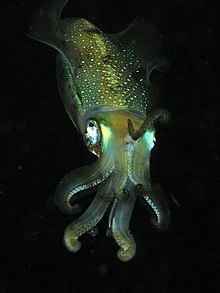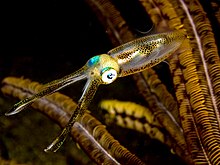
A squid is a mollusc with an elongated soft body, large eyes, eight arms, and two tentacles in the superorder Decapodiformes, though many other molluscs within the broader Neocoleoidea are also called squid despite not strictly fitting these criteria. Like all other cephalopods, squid have a distinct head, bilateral symmetry, and a mantle. They are mainly soft-bodied, like octopuses, but have a small internal skeleton in the form of a rod-like gladius or pen, made of chitin.

A cephalopod is any member of the molluscan class Cephalopoda such as a squid, octopus, cuttlefish, or nautilus. These exclusively marine animals are characterized by bilateral body symmetry, a prominent head, and a set of arms or tentacles modified from the primitive molluscan foot. Fishers sometimes call cephalopods "inkfish", referring to their common ability to squirt ink. The study of cephalopods is a branch of malacology known as teuthology.

Loliginidae, commonly known as pencil squids, is an aquatic family of squid classified in the order Myopsida.

The Caribbean reef squid, commonly called the reef squid, is a species of small, torpedo-shaped squid with undulating fins that extend nearly the entire length of the body, approximately 20 cm in length. They are most commonly found in the Caribbean Sea in small schools. As part of the Cephalopod class of Molluscs, these organisms exhibit specific characteristics to help them in their environment, such as tentacles for movement and feeding and color pigments that reflect their behavioral conditions.

Doryteuthis opalescens, the opalescent inshore squid or market squid, is a small squid in the family Loliginidae. It is a myopsid squid, which is the near shore group and that means that they have corneas over their eyes. The species lives in the eastern Pacific Ocean from Mexico's Baja California peninsula to Alaska, United States, and as an inshore squid it can be found with a range of 200 miles (320 km) off the coast.
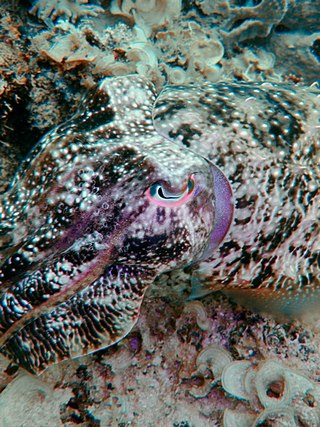
Sepia latimanus, also known as the broadclub cuttlefish, is widely distributed from the Andaman Sea, east to Fiji, and south to northern Australia. It is the most common cuttlefish species on coral reefs, living at a depth of up to 30 m.

The common cuttlefish or European common cuttlefish is one of the largest and best-known cuttlefish species. They are a migratory species that spend the summer and spring inshore for spawning and then move to depths of 100–200 metres (330–660 ft) during autumn and winter. They grow to 49 centimetres (19 in) in mantle length and 4 kilograms (8.8 lb) in weight. Animals from subtropical seas are smaller and rarely exceed 30 centimetres (12 in) in mantle length.

The pharaoh cuttlefish is a large cuttlefish species, growing to 42 cm in mantle length and 5 kg in weight.

Sepia mestus, also known as the reaper cuttlefish or red cuttlefish, is a species of cuttlefish native to the southwestern Pacific Ocean, specifically Escape Reef off Queensland to Murrays Beach off Jervis Bay. Reports of this species from China and Vietnam are now known to be misidentifications. S. mestus lives at a depth of between 0 and 22 m.
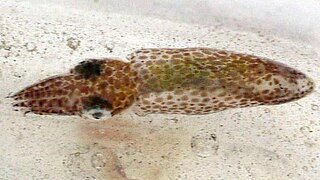
Idiosepius paradoxus, also known as the northern pygmy squid, is a species of pygmy squid native to the western Pacific Ocean. This species can be found inhabiting shallow, inshore waters around central China, South Korea, and Japan.
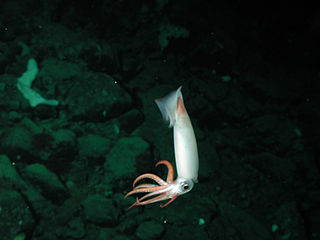
The Gonatus onyx is in the class Cephalopoda, in the phylum Mollusca. It is also known as the Clawed arm hook squid or the Black-eyed squid. It got these names from the characteristic black eye and from its two arms with clawed hooks on the end that extend a bit further than the other arms. It is a squid in the family Gonatidae, found most commonly in the northern Pacific Ocean from Japan to California. They are one of the most abundant cephalopods off the coast of California, mostly found at deeper depths, rising during the day most likely to feed.

Thysanoteuthis rhombus, also known as the diamond squid,diamondback squid, or rhomboid squid, is a large species of squid from the family Thysanoteuthidae which is found worldwide, throughout tropical and subtropical waters. T. rhombus is given its name for the appearance of the fins that run the length of the mantle. They are a fast growing species with a lifespan of approximately 1 year. The diamond squid is the only cephalopod species known to be monogamous. T. rhombus often preys on fish and other small cephalopods at varying water depths. This species is commercially fished in Japan, specifically in the Sea of Japan and Okinawa.

Spawn is the eggs and sperm released or deposited into water by aquatic animals. As a verb, to spawn refers to the process of freely releasing eggs and sperm into a body of water ; the physical act is known as spawning. The vast majority of non-mammalian, non-avian and non-reptilian aquatic and/or amphibious lifeforms reproduce through this process, including the:
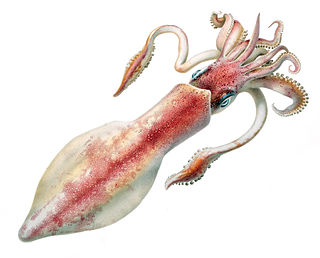
Loligo forbesii, known commonly as the veined squid and long-finned squid, is a commercially important species of squid in the family Loliginidae, the pencil squids.

Cuttlefish, or cuttles, are marine molluscs of the order Sepiida. They belong to the class Cephalopoda which also includes squid, octopuses, and nautiluses. Cuttlefish have a unique internal shell, the cuttlebone, which is used for control of buoyancy.

Sepioteuthis, commonly known as reef squids or oval squids, is a genus of pencil squid. Reef squids are easily recognizable by their large rounded fins that extend along almost the entire length of their mantles, giving them a superficial resemblance to cuttlefish.

Illex coindetii, commonly known as the southern shortfin squid or broadtail shortfin squid, is a species of neritic squids in the family Ommastrephidae. They are found in the Mediterranean Sea and on both sides of the north Atlantic Ocean.

Sepioteuthis australis, commonly known as the southern calamari or the southern reef squid, is a species of reef squid that is native to oceans off the coast of Australia and New Zealand. This species is caught commercially by trawling, as bycatch in the prawn fishing industry and by recreational anglers.

Alloteuthis media, the midsize squid or little squid, is a species of squid in the family Loliginidae from the eastern Atlantic and the Mediterranean Sea. It is generally a by-catch species in trawl fisheries, although there is an active fishery in the western Mediterranean.

Sepioloidea lineolata or more commonly known as the striped pyjama squid or the striped dumpling squid is a type of bottletail squid that inhabits the Indo-Pacific Oceans of Australia. Although traditionally falling within Sepiida, the cuttlefish order, it lacks a cuttlebone. More recent phylogenomic evidence suggests bottletail and bobtail squid may form their own order, Sepiolida. The striped pyjama squid lives on the seafloor and is both venomous and poisonous. When fully mature, a striped pyjama squid will only be about 7 to 8 centimetres in length. Baby striped pyjama squid can be smaller than 10 millimetres (0.39 in).





